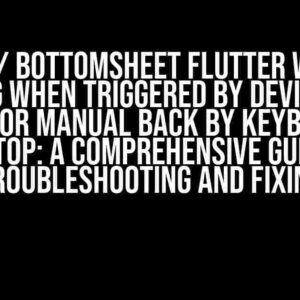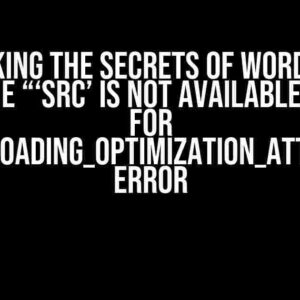Are you tired of scratching your head, wondering why your Next Js app is rendering a dark screen of death in production, only to reveal the ominous “unks” error message? You’re not alone! This frustrating issue has plagued many a developer, leaving them feeling helpless and, well, a little chunked. Fear not, dear reader, for this article will be your beacon of hope, guiding you through the treacherous landscape of Next Js chunking issues and into the promised land of error-free production deployments.
What are Chunks, Anyway?
Before we dive into the meat of the matter, let’s take a brief detour to understand what chunks are and why they’re crucial to Next Js’s workings. In Next Js, chunks refer to the divided pieces of your application’s code, which are generated during the build process. These chunks are then loaded dynamically by the browser, allowing for efficient and faster page loads. Sounds cool, right? Well, it is, until those chunks start causing headaches in production…
The Dark Screen of Death: Understanding the Error
So, you’ve deployed your Next Js app to production, and instead of the beautiful, interactive experience you envisioned, your users are greeted with a dark, unresponsive screen. Panic sets in as you frantically scan the console for clues, only to find the ominous error message:
Error: Chunk Load Error: unks
The “unks” error message is Next Js’s way of telling you that something has gone awry with chunk loading. This error can manifest in various ways, including:
- A blank or dark screen with no error messages
- A chunk load error message with a cryptic “unks” code
- Random JavaScript errors or crashes
The Usual Suspects: Common Causes of Chunk Errors
Before we dive into the solutions, let’s quickly cover some common causes of chunk errors in Next Js:
- Incorrect chunk naming or configuration: Make sure your chunk names are correctly formatted and configured in your `next.config.js` file.
- Missing or incorrectly configured Webpack plugins: Ensure that you have the necessary Webpack plugins installed and configured, such as `webpack.optimize.CommonsChunkPlugin`.
- Incorrectly implemented server-side rendering (SSR): Review your SSR implementation to ensure it’s correctly handling chunk loading.
- Invalid or outdated dependencies: Verify that your dependencies are up-to-date and compatible with your Next Js version.
Step-by-Step Troubleshooting Guide
Now that we’ve covered the common causes, let’s walk through a step-by-step process to troubleshoot and fix the dark screen chunks error in production:
Step 1: Verify Chunk Names and Configuration
Review your `next.config.js` file to ensure that chunk names are correctly formatted and configured. Double-check that you’re using the correct syntax and naming conventions.
module.exports = {
//...
webpack: (config) => {
config.optimization.splitChunks = {
chunks: 'all',
minSize: 10000,
minChunks: 1,
maxAsyncRequests: 30,
maxInitialRequests: 30,
enforceSizeThreshold: 50000,
cacheGroups: {
vendor: {
test: /[\\/]node_modules[\\/]/,
name: 'vendor',
chunks: 'all',
priority: 10,
reuseExistingChunk: true,
enforce: true,
},
commons: {
name: 'commons',
chunks: 'all',
minChunks: 2,
priority: 0,
reuseExistingChunk: true,
enforce: true,
},
},
};
return config;
},
};
Step 2: Check Webpack Plugin Configuration
Verify that you have the necessary Webpack plugins installed and configured. Make sure you’re using the correct versions and configurations for plugins like `webpack.optimize.CommonsChunkPlugin`.
const webpack = require('webpack');
module.exports = {
//...
plugins: [
new webpack.optimize.CommonsChunkPlugin({
name: 'commons',
filename: 'commons.js',
minChunks: 2,
}),
],
};
Step 3: Review Server-Side Rendering (SSR) Implementation
Review your SSR implementation to ensure it’s correctly handling chunk loading. Double-check that you’re using the correct syntax and configurations for `getStaticProps` and `getServerSideProps`.
import { GetServerSideProps } from 'next';
export const getServerSideProps: GetServerSideProps = async (context) => {
//...
return {
props: {},
};
};
Step 4: Update Dependencies and Verify Compatibility
Verify that your dependencies are up-to-date and compatible with your Next Js version. Run `npm outdated` or `yarn outdated` to check for outdated dependencies, and update them accordingly.
npm outdated // or yarn outdated
Step 5: EnableVerbose Mode and Analyze Console Logs
Enable verbose mode in your `next.config.js` file to gain more insights into the chunk loading process. Review the console logs to identify any errors or warnings related to chunk loading.
module.exports = {
//...
verbose: true,
};
Step 6: Use the Next Js Built-in Chunk Analyzer
Next Js provides a built-in chunk analyzer that can help you identify issues with chunk loading. Use the `npx next chunk-analyzer` command to analyze your chunk configuration.
npx next chunk-analyzer
The Silver Bullet: Using the `fallback` Option
In some cases, the chunk loading issue can be resolved by using the `fallback` option in your `next.config.js` file. This option allows Next Js to fall back to a different chunk loading strategy if the initial attempt fails.
module.exports = {
//...
webpack: (config) => {
config.optimization.splitChunks = {
//...
fallback: true,
};
return config;
},
};
The Grand Finale: Production Deployment
Once you’ve troubleshooted and resolved the chunk loading issue, it’s time to deploy your Next Js app to production. Make sure to test your app thoroughly before deploying to ensure that the chunk loading issue is resolved.
| Deployment Option | Command |
|---|---|
| Vercel | vercel deploy |
| Netlify | netlify deploy |
| Custom Deployment | npm run build && npm run start |
With these steps, you should be able to troubleshoot and resolve the dark screen chunks error in production. Remember to stay calm, patient, and methodical in your troubleshooting approach. Happy coding!
Conclusion
In this article, we’ve walked through the mysterious case of the Next Js dark screen chunks error in production. By understanding the causes, following the step-by-step troubleshooting guide, and using the `fallback` option, you should be able to resolve this pesky issue and deploy your Next Js app to production with confidence. Remember, the Next Js community is always here to help, so don’t hesitate to reach out if you need further assistance.
Happy coding, and may the chunks be ever in your favor!
Here are 5 Questions and Answers about “Next Js dark screen chunks error in production”:
Frequently Asked Questions
Get answers to the most common questions about Next.js dark screen chunks error in production!
What is the dark screen chunks error in Next.js production?
The dark screen chunks error occurs when Next.js is unable to load certain chunks of code in production, resulting in a blank or dark screen. This issue is often caused by incorrect configuration, plugin issues, or optimization problems.
Why do I see a dark screen when I navigate to a page in my Next.js app?
This could be due to a chunks error. Check your browser console for errors, and make sure that you have correctly configured your `next.config.js` file. Also, ensure that you’re using the correct version of Next.js and its dependencies.
How can I troubleshoot the dark screen chunks error in Next.js production?
To troubleshoot the issue, try the following steps: 1) Check your browser console for errors. 2) Verify that your `next.config.js` file is correctly configured. 3) Ensure that all dependencies are up-to-date. 4) Review your plugin configurations. 5) Optimize your code to reduce chunk sizes.
Can I fix the dark screen error by adjusting my Next.js optimization settings?
Yes, adjusting your optimization settings in `next.config.js` can help fix the dark screen error. Try setting `optimizeCss` to `false` or adjusting the `chunkSizes` to reduce the size of your chunks. This can help alleviate the error and improve your app’s performance.
What are some common causes of dark screen chunks error in Next.js production?
Common causes of dark screen chunks error include: 1) incorrect `next.config.js` configuration. 2) Plugin issues or conflicts. 3) Code optimization problems. 4) Incorrect dependency versions. 5) Large chunk sizes causing loading issues.





